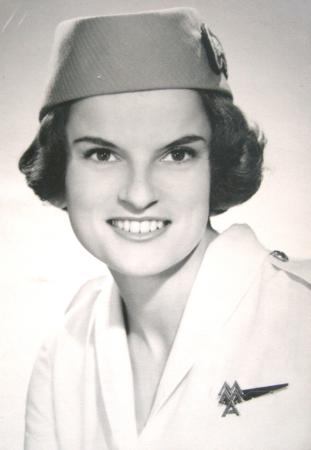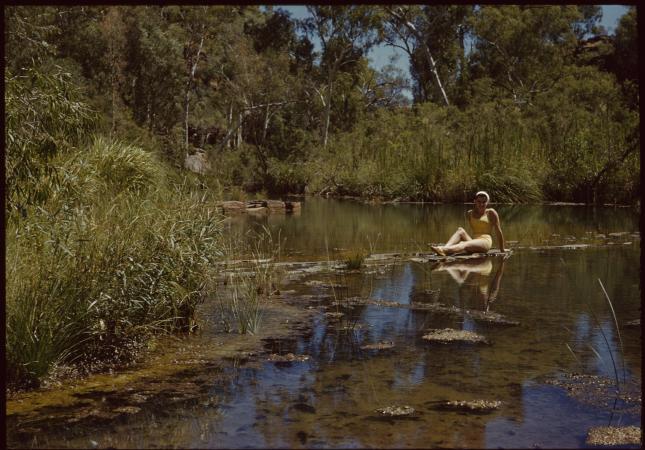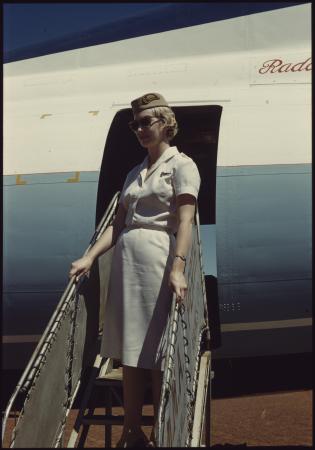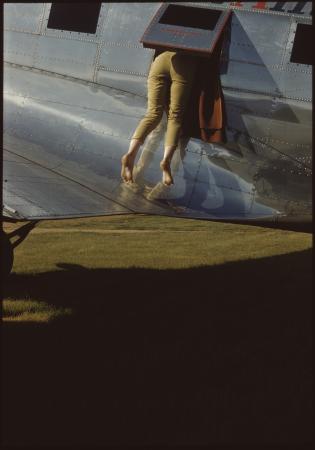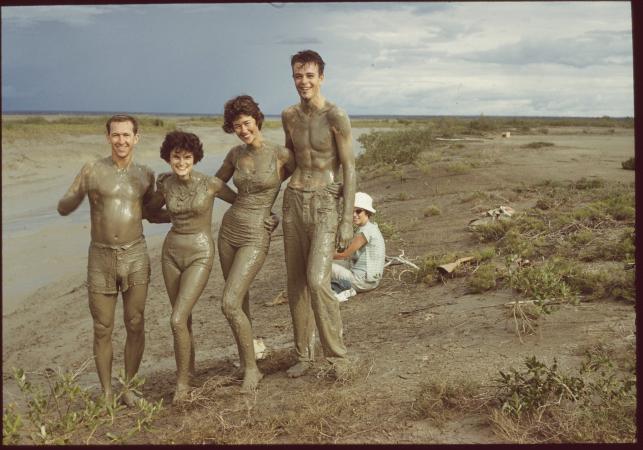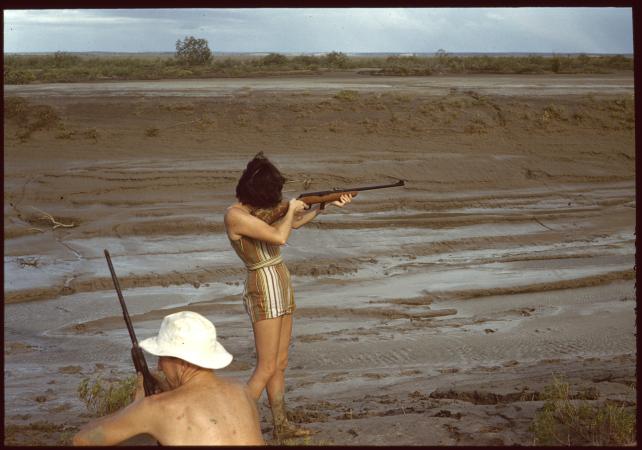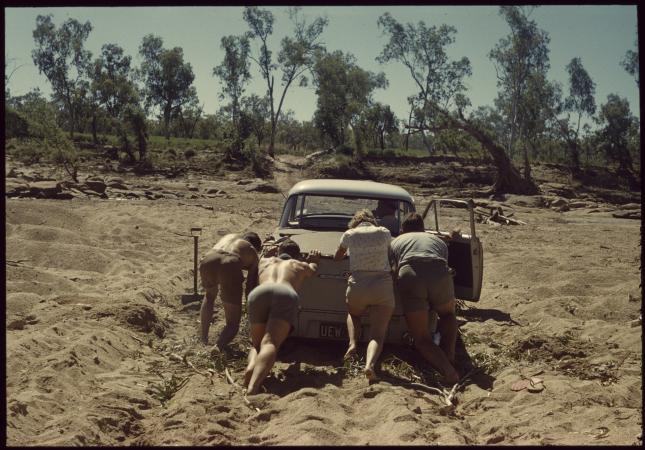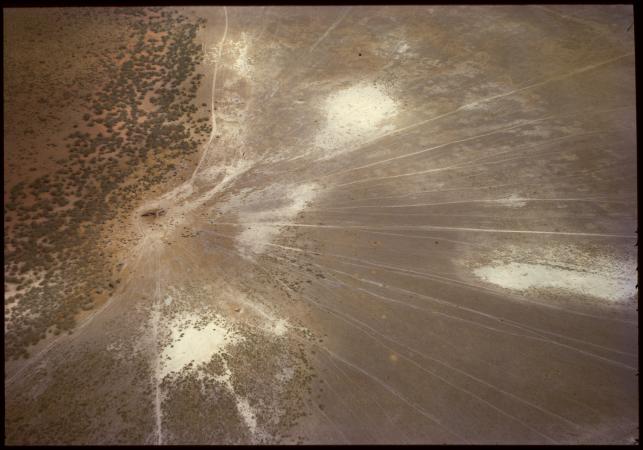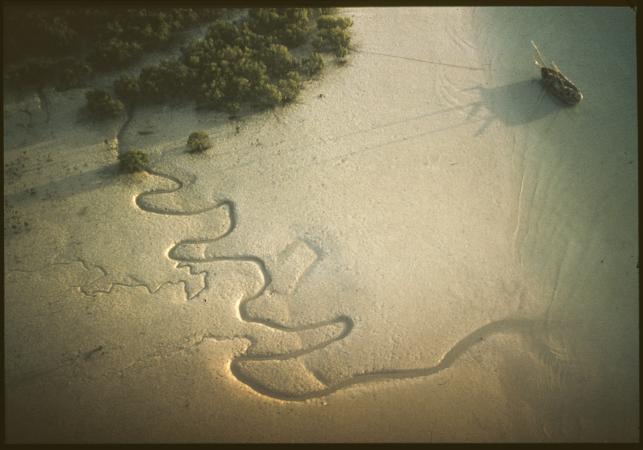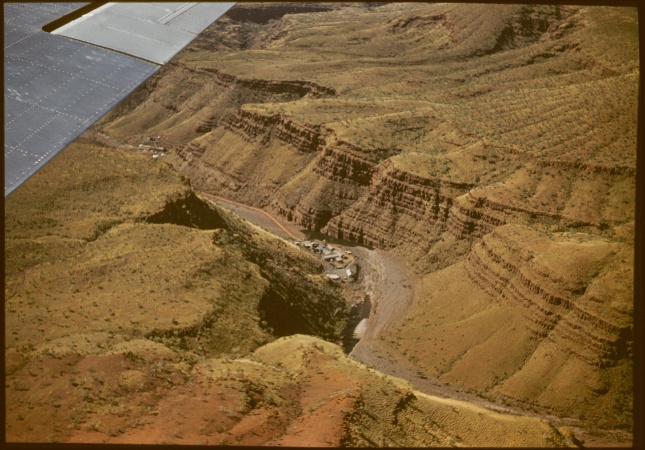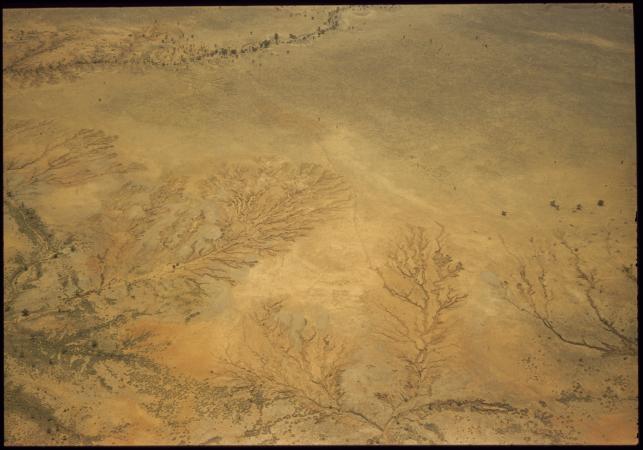Listen to an interview with Betty Foster (a flight attendant in the 1950's and 60's) and Geoffrey Thomas (aviation editor for The West Australian newspaper) as they discuss how Betty's colour photographs introduced National Geographic to remote WA and how she paved the way for aerial photographers today.
This interview was done after a post on the State Library of WA's Facebook page sparked interest in the air hostess and her magnificent photos, many of which can be found in the State Library's collection.
Most of Betty's photographs were taken with an East German Werra camera loaded with Kodachrome film. The aerial photographs were captured from the back seat of a Douglas DC-3.
Betty's photographs prompted the National Geographic magazine to visit Western Australia for the first time in 1963 after she crossed paths with Alan Villiers, the captain of the Mayflower II. He sent a handful of her slides to National Geographic and the next day they asked for 200 more.
Some of her images were even included in the September issue of the magazine that year.
Recorded live on ABC Radio Perth on 21st January 2022.
Transcript
BEGINNING OF INTERVIEW
Host: It’s nice to welcome this segment back for 2022. My next guest was not only travelling around WA as an air hostess, she was also documenting it all with her camera. From Cable Beach to Rottnest Island, the photos she took inspired National Geographic to come out to explore little old WA in 1963. Her name is Betty Foster, and she joins me in the studio. Good afternoon, Betty.
Betty: Afternoon.
Host: Thank you for coming in and very nice to meet you, aviation editor Geoffrey Thomas, thank you for coming in too.
Geoffrey: Our pleasure.
Host: Now, I was handed this book about 10 minutes ago and it's been very hard to get any work done ever since, Betty, because the photos are phenomenal. Why did you want to become an air hostess?
Betty: I was overseas for two years roaming the world on my own through America and I went on a small plane, it had no doors and the pilot decided to loop-the-loop. When I came down, I thought, "that was fun." So, when I came home after two years I thought, well what better way to see Western Australia. I'd seen the world and that's why I joined MMA.
Host: And you survived a loop-the-loop! [Laughs]
Betty: And I survived a loop-the-loop.
Host: Incredible. So, what was it like to get into that job at the time, if I can ask?
Betty: Well, there was 35 hostesses, you had to have some form of nursing and I trained at the Dental Hospital. So, the nursing was a three-year training, but you went to theatre, and you did all sorts of things that... 'cause I was wanting to play squash.
They'd just opened to females, squash courts at the Adelphi Hotel. So, I didn't want to do full time nursing so that's why I did it.
Host: And what was it like at the time?
Betty: Oh, it was very... it was too exciting, you can't imagine. You were going into a world that I didn't know existed because, Western Australia, there was no tourists, there was nobody to bring home and coloured photographs, they were all black and white in the 50s. And they were an expensive thing to do, to take the slides, films. So luckily my parents didn’t charge me board and lodging so it all went, every flight I took my camera. So, I ended up three times a week wherever I went taking photographs.
Host: These photos that sit in front of me in this wonderful book called A Bird’s Eye View, these were taken whilst you were working as an air hostess.
Betty: Yes, the back window of a DC3 is clear glass. And of course, you don’t go above 10,000 feet. So, I was paid for a year to do this work which nobody now could afford to do. It’s just, you know, it was exciting. And I love DC3s, so I think they’re the most beautiful aircraft that man's ever put together.
Host: I can see now why you and Geoffrey Thomas get along, and why you were happy to come into the studios to talk about Betty. Now, Geoffrey, how would you describe this collection of photos?
Geoffrey: This is a State asset. It's a magnificent collection of photos. When I first laid eyes on it in 2009 I just re-joined the west and, a couple of colleagues said, "we're about to send this back to Betty Foster, we can't quite see what the value is.”
And I said, "yeah you kidding me!" And that started a journey. And we ran a big splash article in the Weekend West Magazine - The Lady with the Lens - and that started a journey where we've worked with Betty, over the years we've done a number of stories.
We've got some of her collection over Perth. The aerials of Floreat and City Beach and different places in Perth. We then put a helicopter up. And we then took the -
Host: Side-by-side.
Geoffrey: -Side-by-side pictures of what it's like today, and this is a few years ago now, and we ran a series there, we did it with Channel 7 as well.
So, we've done lots of work with Betty, and one of the suggestions we made to Betty was, this is so good, it needs to go to the State Library, which...
Host: And here we are.
Geoffrey: And here we are, and the State Library has done a lot of work with it and, it really is, as I said, it's a State asset.
Host: Can you tell me about some of these photos, Betty, because I can see what you can see, but what was happening in the background?
Betty: [Laughs] What are the photos?
Geoffrey: One of the photos is when Betty and her co-hostess and two pilots are covered head to toe in mud. [Laughs]
Host: [Gasps] What's going on with that? Tell me!
Betty: Well, when I did two trips to Derby in the wet season and the dry season, and the young mutineers up there knew that I was fearless so if there was anything on, they would do it while I was there.
So, they liked to go out catching fish, but they had to go out when the tide was down. They'd shoot and get little, tiny fish. And then we would slide down in the mud and collect these little fish as bait, for when the tide came in, they'd catch barramundi. So, what we were doing, we were coming up from having slid down and caught all these little fish.
Host: Yeah, you were head-to-toe in mud. [Laughs]
Geoffrey: There's also magnificent photographs of Cable Beach, there's not a soul on Cable Beach. And of course, today, there's no chance you'd ever get a photograph like that.
So, there’s all these, sort of, gorgeous pictures of... wow, I never knew it, like Port Hedland and there's hardly a ship around. Now you've got these massive iron ore carriers everywhere. It's a great then-and-now type comparison.
Host: Definitely. It's 20 minutes past 2 on ABC Radio Perth, in WA. I'm having a lot of fun. History Repeated. Today I have Betty Foster, in the studios, air hostess and aerial photographer, alongside aviation editor Geoffrey Thomas, and we're talking about her incredible work. Which were some of your favourite trips, Betty? What do you like to reflect on?
Betty: One was taking a photo of a rock in Arnhem Land… shows two faces. And afterwards the pilot says to me, "now if anyone in Head Office asks you how you got that photo, you've got the tell them you had a long lens.” 'Cause in actual fact, we were flying over another rock, which was very, very close, and the pilot also knew that I really was bona fide, and they would take me to places normally these planes wouldn't go.
Host: Really?
Betty: Yes, we'd chase water buffalo down the Victoria River. We did all sorts of...
Host: [Laughs] Don't stop there!
Betty: [Laughs]
Host: Don't stop there, Betty!
Betty: Because I was fearless, you know, it was just one of those things. Things happened around me, and then we had an engine failure on take-off, with the fire coming out the left engine and I had two passengers. One was drunk and one was a middle-aged lady.
And I looked up and I said, "how'd you like to spend a few nights in Roebourne?” And we both grimaced. And I knew she had to be from the North, because flames coming out of an engine didn't worry her. Just another thing to cope with.
Host: Good to know.
Betty: So, when we landed, I was talking to her and she had a string of pearls around her neck, and they were huge, and I naturally thought - Coles or Woolies. but on the third day she said to me, "no, my husband was in pearling. it took him 30 years, they're all the same size and they're natural pearls." Insurance on those could have bought two DC3s, if that plane had gone down.
Geoffrey: And a little segue to that story. I met that lady recently up at Cygnet Bay and, we drove up to Cygnet Bay last year and had dinner with her so that was a little twisted, that story.
Host: The necklace, is it still in circulation?
Betty: I don't know, I haven’t asked her.
Host: [Laughs]
Betty: Bit of a book.
Geoffrey: One of the other photographs that I really love was the DC3 I think was at Billiluna. And there’s a beautiful photograph that Betty’s taken from underneath the aircraft. Like that. And in the background there, there are two pilots and they've both got wildflowers.
Host: Yes, you can see the propeller.
Geoffrey: They've gone to pick wildflowers. I mean, that's the sort of gorgeous things that happened in those days.
Host: And who did you meet in your travels, Betty?
Betty: Well, I had Premier Brand on one flight, and I was accused of going too fast. And I thought, well there was the whole plane full, there’s only one hostee.
The other time I had the Chief Justice on board. We had to land at Meekatharra 'cause Perth was in fog. And so half of them went into the pub for the night. And the rest of the half, it was freezing cold, it was below... They've got blankets and things, and they all cuddled up. Well at two in the morning, the other half decided to come back. Now it was pitch dark, and there was absolutely bedlam in the plane, there people having to wake people and grab, they had two blankets and they were only allowed one, so they were grabbing blankets.
And, of course, the men were a little bit merry, so I had to go up to the cockpit to hide myself for a while. [Laughing]
Host: Oh... Good idea. The times, they were different.
Betty: Yes, they were different in times. No, but they were very good, the pilots, I couldn't speak more highly of them.
Host: Yeah. Do you still -
Betty: Most of them are wartime. No, they've all passed away. I think there's one still alive. But they used to relate their wartime stories.
Two 18-year-olds in a Lancaster coming over to Gibraltar and they were told "don't go near Gibraltar, there's flack." And of course they did, didn't they. They were flying to Africa with supplies. But these are the stories, and one bought a DC3 in with no engines. He glided it into New Guinea, didn't he.
Yeah. Oh yeah it was extraordinary stories they were telling me, but the passengers had fabulous stories.
Host: Yeah?
Betty: The women of the north were an extraordinary bound of women.
Host: Tell me!
Betty: Well, one lady would come out every two months with a tablecloth, scones and jam, and two thermoses and give afternoon tea for the entire passengers and crew.
Host: Ooh!
Betty: They tried to stop it in Perth but [laughing] she was a strong lady. And so it continued for a long time 'cause it was holding up the schedule, but who worries about a schedule.
Geoffrey: At Tableland Station.
Betty: Yes, Mrs. Delower.
Host: That is so thoughtful, you couldn't do that in covid times, could you. Did you run into any names that we might know, Betty?
Betty: Well, Lang Hancock, he used to… Wittenoom, I was twice in Wittenoom because the weather closed in on us, and we learnt on the radio, from London, that Lang had just mentioned the iron ore. And that was the first we'd ever heard about it. We had been taking geologists in there. And so, it was the very beginning. That moment was when it all really, Perth, started to evolve.
Host: Do you remember what year that was?
Betty: '61.
Host: '61. And you met a very young magnate. Who was that?
Geoffrey: Young Gina.
Betty: Oh, Gina, she was a schoolgirl. She used to fly out to her station in the holidays. Yes, I think she was about... I'm not sure, I better not say, what, dates and names.
Host: [Laughs] That's alright, look, I mean, people flew. I mean, yeah, in times gone by, right. Geoffrey, you've seen this book. You've seen it in detail. Which photos stand out to you and why?
Geoffrey: One of the ones I think is really cute is a DC3 and a Fokker Friendship at Derby, and the pilot and the mechanics and whatnot are sitting in wicker chairs having a cup of tea on the tarmac. I mean, it's just the sort of thing you just wouldn't see today.
Host: I'm looking at it. [Laughs]
Geoffrey: I mean, there are so many photographs, and one of the things that really strikes you is the aerial shots of the rivers and the estuaries, and all that sort of photography has now become an art form, when you've got people today like Peta-Anne North who does fabulous work in that space, aerial photography, and you look at the photography and you think, “wow! This is just mind-blowing”, sort of pictures. Betty pioneered all of that. And that's one of the things that really hooked the National Geographic, is some of these incredible waterways that we have up there.
Host: It takes a lot of technology, and hundreds of people to do what you did.
Betty: [Laughs] Yes, I know. I was just lucky to have that one yeah, in DC3s. Because we then went to the Fokker Friendship, which flew at 30,000 feet and the windows were tinted. It wasn't clear. See these were all… and they washed the windows every time the DC3 landed, so you wouldn't know there were all taken through the window.
Host: No, you wouldn't! And we've all taken a photo through the window of an aeroplane, and all we get is clouds. [Laughs]
Geoffrey: And the other beauty is that Betty was using Kodak film, Kodak colour film, Kodak slide film, which is the best in the world you can get. I mean, and you look at these pictures and it's like they were taken yesterday. The colour has held. Some other brands fade away, but Kodak colour held.
Host: The resolution.
Geoffrey: The colour, the clarity is just gorgeous.
Host: Yeah, I'm looking at the mangroves on the tidal flats near Wyndham, ah, and the Ord as well, and you've got wildflowers in that area too. Do you miss it sometimes, Betty?
Betty: Well, I married and had four children, so I think I was so busy. [Laughs] It wasn't 'til they'd all left home that I, sort of brought out the slides.
Host: [Laughs] Did you ever have near misses in the planes, you mentioned -
Betty: Oh yes, Perth Airport. We were coming in on DC3 and I looked down and saw the fire brigade all running 'round on the… Oh, there's a plane in trouble, and just then the bell rang from the cockpit. I went up and he said, "oh, Betty, you better go back and check everybody's seatbelts. The light to say the wheels have come down hasn't come off."
Now when I came out of the cabin, they all knew, they were looking out the windows, they could see the fire brigade and realised I was going to test them a second time, which most of the men enjoyed. And then, they were extraordinary. All those men said something really worthwhile to me, to boost me to say, "look, we're all in this together." And by the time I finally sat down… And they were even making some jokes, and by the time I sat down I was actually smiling.
Anyway, we held up all the planes, QANTAS, Ansett and TAA, but we came in safely. Beautiful landing.
Host: Good to know. What is it like to fly now - when was the last time you took a flight?
Betty: We've got a daughter in England. I've flown, but I don't like these planes, they shudder and they shake. the DC3 used to sort of… waltzed, it waltzed through the sky. That's how I could say it. And most of these pilots were wartime pilots so they would land on these dreadful strips and you wouldn’t know you'd landed.
Host: What would you say to that, Geoffrey?
Geoffrey: Spot on. The MMA pilots were an incredible group of people who had done it all. They'd, as Betty said, flown Lancasters, Mosquitos, Spitfires, Hurricanes. They were just an extraordinary group of incredible high skilled pilots. Seat of the pants stuff, they just absolutely knew, and they knew the Northwest like the back of their hand. They really did, and they were flying into all sorts of obscure places that you'd just never heard of and landing on a sixpence.
Host: National Geographic got hold of some of your photos, they came to WA. What was that experience like, Betty?
Betty: Well, I was seconded to open a tourist bureau in Darwin with the West Australian government for 3 months, and this man walked in, and he said, "my name is Alan Villiers."
Now I'd been in America, and I knew Alan Villiers. He was the captain of the ship The Endeavor to Australia, and also the captain of the ship of The Mayflower, and I'd been on it. So, I said, "not captain Alan Villiers?" And of course, he cried, somebody recognised him in Australia.
And then he was going on the Fokker when I said, "look, you should really go on the DC3, you'll see more." That night I handed him 15 slides, and the next morning he was there at 9 o'clock and said, will I send them to National Geographic, and they asked me for 200.
Host: [Gasps]
Betty: And then they asked me to find out where the river was in Wyndham, the photo they finally put in, and I was in London. So, Westralia House had some maps, so there we were finding out the name of the King River.
Host: Wow.
Betty: In London.
Host: You put us on the map.
Betty: I put you on the map, yes. [Laughs]
Host: Yeah! Thanks for that, by the way Betty. [Laughs] Yeah, not bad hey. So, have you kept up with your photography?
Betty: Oh yes. I did another two years overseas, and my friend said to me, "well Betty, you realise you've got all these extraordinary photos of your four years overseas." And one of them was going over to East Germany when they were putting up the wall.
Host: [Gasps]
Betty: We were held up by soldiers with guns and I and then I was in Washington when Kennedy was assassinated, and I was actually showing these slides at a girl’s school, when the headmistress came in and said, "Kennedy's been shot, we don't know if he's dead or not."
And I said, "what do you want me to do?"
She said, "well just...go and show the slides." So, I did, and then at the end of it she came out and said that Kennedy was dead. But in that hour that I was showing them, the parents of all those children came and when I went out a half an hour later, it was not one child left in the school. They'd come to collect their children. They were terrified. And then we spent three days just watching television. I actually saw the killer being shot as it actually happened, yeah.
Host: Wow. Betty, can you come back-
Betty: [Laughs] No, no!
Host: - in the studio. Can we do this again?
Betty: Hard enough to get me in, you've got me in...
Host: You know it’s funny I look into the producer booth and there’s a crowd of people not doing a thing, not taking a phone call, just looking at you and just listening, because you've lived such an amazing life.
Your book, people will want to see it, they will want to go to the State Library and check out your work. If they do want a copy of A Bird’s Eye View, from 60 years ago, how do they acquire such a thing?
Betty: birdseyeviewbook@gmail.com
Host: Okay, it's an email. Wonderful.
Betty: It's an email.
Host: birdseyeviewbook@gmail.com
Betty: My neighbour, who's university educated, decided to help me so both of us, we've got both Gmails. Well at this age I really didn’t think I’d be doing this of course.
Host: Well, I am glad that you are doing this. Geoffrey, any last words? That sounds dramatic.
Geoffrey: Oh look, it's an outstanding book, a stunning book. It's, as I said before, a fabulous asset for the State and I'm thrilled that Betty agreed to give it to the State Library and they're the keeper of this treasure.
Host: Definitely. Well, thank you both for coming in. Geoffrey, nice to meet you.
Geoffrey: Lovely to meet you.
Host: Geoffrey Thomas, aviation editor and Betty, I would love to have a chat with you again. This has been amazing.
Betty: Oh... I'll see.
Host: [Laughs] Betty Foster. So, aerial photographer and air hostess as well. You have to check out these works. As I mentioned, she is the reason why National Geographic came to see us in 1963, but the book itself is just beautiful.
You can read two fantastic stories on Facebook about Betty Foster, Melting Mascara, Shorts And Thongs and Take To The Skies With Betty Foster.

